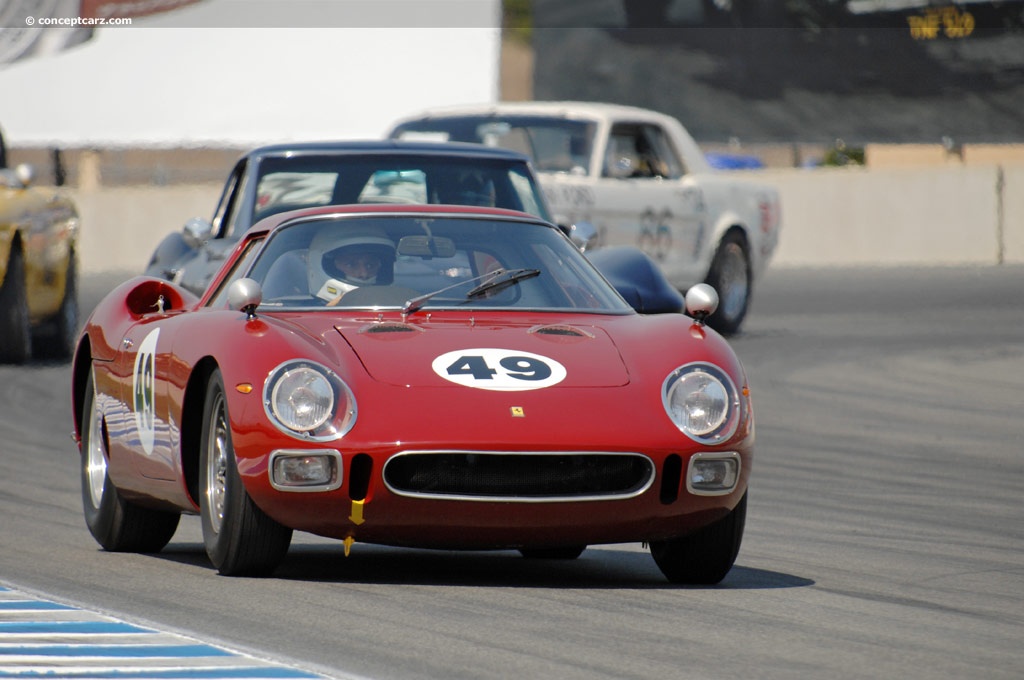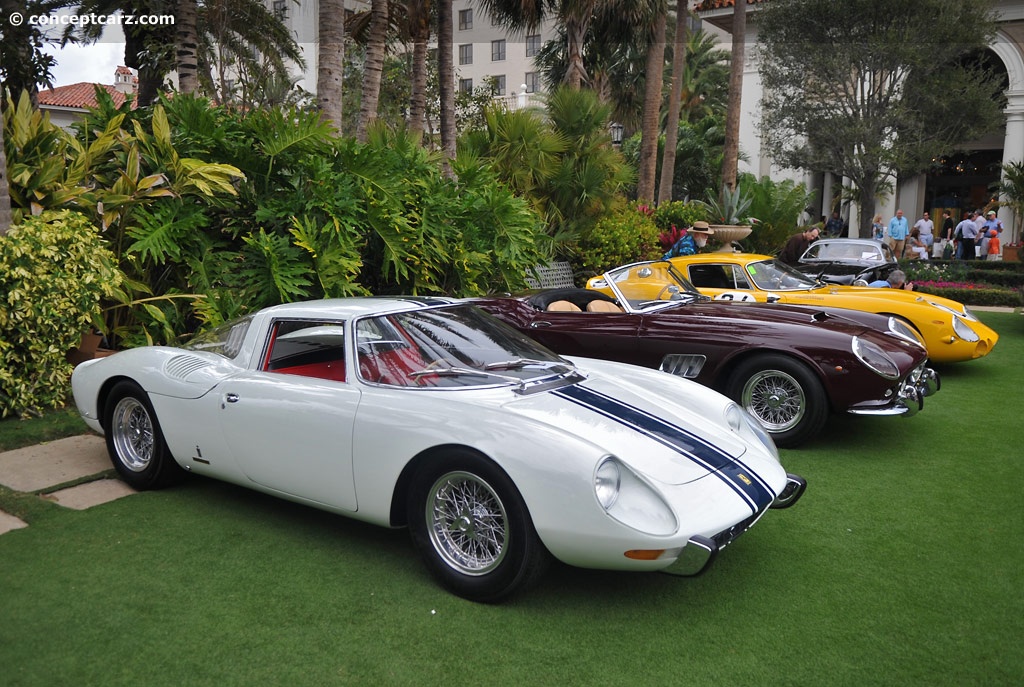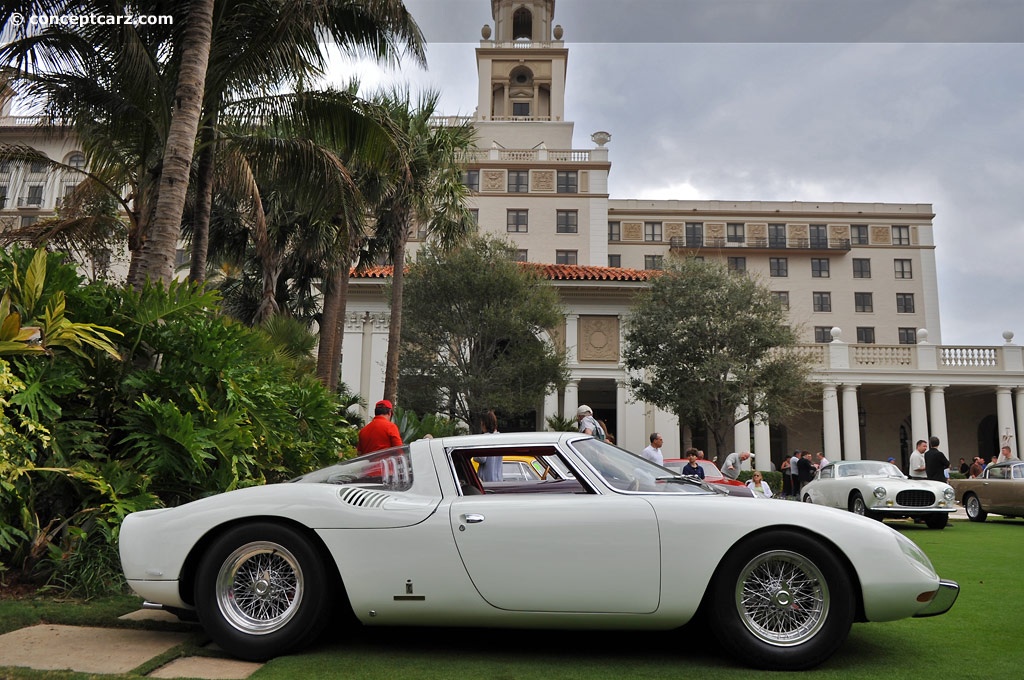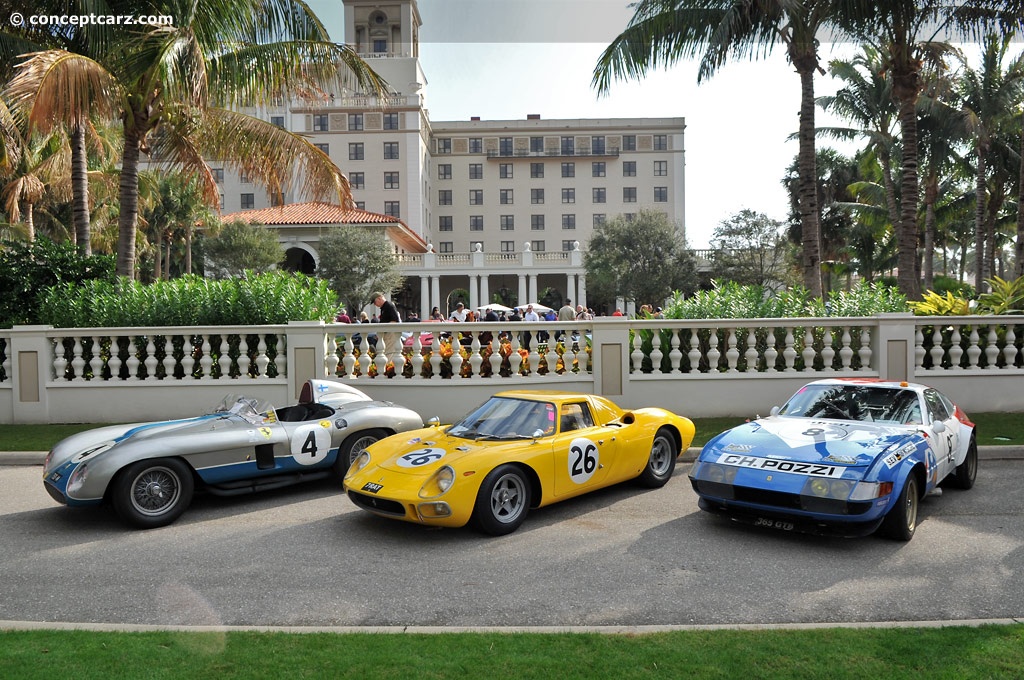The Ferrari 250 Series of sports cars had an unrivaled record on race tracks throughout North American and Europe and swept the podiums at events ranging from the 12 Hours of Sebring to Italian hill climbs and 24 Hours of LeMans. The lightweight, rear-mid engined Ferrari 250 Le Mans, named in honor of the famous track where Ferrari had enjoyed success since 1960, was the company's 1964 entrant into sports car racing. 
Coupe by Pininfarina
Chassis #: LM 6045The history of the Ferrari 250 LM begins with the 250 GTO, whose competitors argued that it did not meet the homologation requirements that dictated 100 examples or more must be built. They were right of course, but Enzo Ferrari argued that the 250 GTO was a variant of the 250 GT SWB Berlinetta, of which more than enough cars had been built. The argument worked, allowing the 250 GTO to race, where it earned many victories for the Scuderia Ferrari, and the many privateers who also campaigned the berlinetta. By 1962, the 250 GTO was aging and a replacement was needed. Starting in 1961, Ferrari began experimenting with a new type of car with a mid-engine configuration. A series of V6 and V8 prototypes were constructed, and dubbed 'Dino' after Ferrari's late son. The early success convinced Enzo that he was on the right track. The new layout offered superior weight distribution, and by positioning the engine over the driving wheels, traction was greatly improved. While development continued on the chassis, work continued on a variety of engines. The work was ultimately slowed by the infamous 'palace revolt,' where several of Ferrari's leading engineers left the company following a dispute over several issues. Enzo's character may have made him a difficult individual to work for, it was also responsible for a large part of his success. 
Coupe by Pininfarina
Chassis #: 6025
View info and historyAfter Enzo learned that one of the defectors, Ing. Carlo Chiti, was developing a V8 engine for ATS, he immediately put a halt to Ferrari's V8 project, and instead refocused his efforts on the tried-and-true Colombo-designed single overhead cam V12. The result was the 250P, incorporating a rear mounted transaxle and a dry sump version of the V12 engine. It was given front-mounted oil and coolant radiators, and four of the chassis tubes were used as coolant and oil lines. Among the many accolades of the 250P was a victory at LeMans in 1963, driven by Scarfiotti and Bandini. The second place went to a Ferrari 250 GTO, and third to another 250P, earning Ferrari a 1-2-3 dominant finish. 4th, 5th, and 6th place also went to V12 powered Ferraris (a 250 GTO in fourth, a 330LMB in fifth, and a 250GTO/LMB in 6th). The Ferrari 250 GTO had demonstrated it was still a fierce competitor by finishing 2nd at LeMans in 1963, it was time to be replaced. Enzo's solution was to put a roof on the 250P. Pininfarina was tasked with converting the 250P into a berlinetta that could be homologated to race in the GT class. The 250 Lm made its official debut in 1963 at the Paris Motorshow, however the production version was not ready until 1964. The main differences between the prototype example shown at Paris and the production versions were the engine displacement. 
Coupe by Pininfarina
Chassis #: 6025
View info and historyOnce again, Enzo tried to convince the FIA that the new 250 LM was a variant of the 250 GTO. The Ferrari traditional naming scheme, until the early 1990s, followed a three-number formula based on the engine displacement and the number of cylinders. For V12 powered cars, the name was based on the displacement (in cubic centimeters) of one cylinder. Nearly all of the Ferrari 250 cars shared the same Colombo Tipo 125 V12 engine with 2953cc displacement (250cc per cylinder). All but the first prototype 250 LM cars were fitted with the 3.3-liter (275cc per cylinder) version of the Colombo V12, and thus - by Ferrari convention, should have been called the 275 LM. Instead, Enzo hoped that by sticking with the '250' name, it would convince the FIA officials to homologate the 250LM for GT competition. This time, the FIA officials were not convinced that the radically new sports car with its all new bodywork, rear engine and transaxle, was related to the GTO. The 250 LM was denied homologation status, and the cars were required to compete in the much more competitive prototype classes. During the 1964 season, the 250 LM would be entered in over 50 races, within over a dozen of them outright, and earning numerous podium finishes along the way. It first major victory was in the Rheims 12 Hour Race on July 4th/5th of 1964. Maranello Concessionaires' 250 LM finished first, ahead of NART's sister car, and defeating the official Fords. Maranello Concessionaires' GTO also finished third to defeat the Cobras in the GT category. Notable victories and podium finishes include races at Snetterton, the Coppa Intereuropa, the Kyalami GP, and Elkhart Lake, driven by drivers that include Roy Salvadori, David Piper, Willy Mairesse, and Nino Vaccarelli. Chassis number 5893, entered by the North American Racing Team (NART) won the 1964 24 Hours of LeMans driven by Jochen Rindt and Masten Gregory. 
Coupe by Pininfarina
Chassis #: 6313
View info and historyDuring the 250 LM's racing career, lasting from 1964 through 1967, they were raced by Scuderia Ferrari, NART, Maranello Concessionaires, Ecurie Filipinetti, Ecurie Francorchamps and others. Enzo would make another attempt at having the cars homologated for GT competition, and was again denied. He tried to convince FIA officials that 100 examples had been built, with 47 examples resided in the United States. This was not true, as only 32 examples of the 250 LM were produced. The prototype was chassis number 5149, followed by a run of cars, ranging from S/N 5841 through S/N 6321, all made in 1964. Chassis number S/N 8165 was built in 1966. All of these cars were numbered with odd serial numbers. Outraged by not having FIA homologation, Enzo announced he would withdraw from racing for the 1965 season. This left the 250 LM in a sort-of-limbo, as the factory needed 100 examples built to homologate it for racing, but privateers needed proof that the car was successful in competition. To get this success, the car needed to compete in the GT category. And to complete this chicken-and-egg scenario, the car had to be homologated. 
Coupe by Pininfarina
Chassis #: 6313
View info and historyDespite the low production numbers, the factory produced a full owner's manual and at least three distinct sales brochures for the 250 LM. It is not clear why this much effort was made, as it had not done for other models such as the 250 GT PF Cabriolet and Berlinetta Lusso. Perhaps it was a Herculean effort to trick FIA officials into allowing it to race? For whatever reason, the 250 LM was finally given its unqualified (only 32 examples built) homologation status in 1966. By this point in history, the 250 LM was no longer competitive in the GT class.Although Enzo had threatened to stay out of competition for the 1965 season, he may have been rejuvenated by John Surtees winning the World Drivers' Championship in 1964, as the factory team was back in 1965. The Ferrari 250 LM was not as successful as its predecessor, but it did have its share of victories and disappointments. 32 examples were built with one capturing the overall victory on one of the world's most grueling and competitive events - the 24 Hours of LeMans. Beginning with the 166 MM in 1949, Ferrari has won at Le Mans 9 times, with the N.A.R.T. entered 250 LM capturing Ferrari's last victory to date.
by Daniel Vaughan | Feb 2020

Coupe by Pininfarina
Chassis #: LM 6045

Coupe by Pininfarina
Chassis #: 6025
View info and history

Coupe by Pininfarina
Chassis #: 6025
View info and history

Coupe by Pininfarina
Chassis #: 6313
View info and history

Coupe by Pininfarina
Chassis #: 6313
View info and history
by Daniel Vaughan | Feb 2020
Related Reading : Ferrari 250 LM History
Ferraris unstoppable 250 GTO racer, with its brutal performance and beautiful lines, was replaced by the 250 LM. Though the LM, too, was a great looker with formidable capabilities on the track, it was a wholly different vehicle from the GTO. While the GTO followed the storied Ferrari tradition of stuffing twelve cylinders between the front fenders, the LM had its V12 mounted amidships. Placing....
Continue Reading >>
Continue Reading >>
Related Reading : Ferrari 250 GT History
Production of the 250 Series began in 1954 and continued on through the early part of the 1960s. There were numerous variations of the 250 and would ultimately become Ferraris most successful line of vehicles to date. The 250 is also recognized as the first Ferrari to ever receive disc brakes. This did not take place until the end of the 1950s. Also, the 250 was the first four-seater. Ferraris....
Continue Reading >>
Continue Reading >>
Similar Vehicles
Similar Automakers
1965 Ferrari 250 LM Vehicle Profiles
Recent Vehicle Additions
Performance and Specification Comparison
250 LM Specification Comparison by Year
Year
Production
Wheelbase
Engine
Prices
Related Automotive News

1965 24 Hours of Le Mans: A Cool Head in the Face of a New Threat
Heading into the 1965 24 Hours of Le Mans it had become clear Ford was intent on taking the fight to Ferrari. Ford would spare no expense to take the fight to the company it had intended to buy. Ironically, the North American Racing Team would enter...

Ex-Surtees race-winner and rare Chinetti-commissioned Spider join Salon Privé's Ferrari 75th Anniversary class
Salon Privé Concours dElégance presented by Aviva introduces pair of important Maranello models - from road and track - in its Ferrari 75th Anniversary class
#1 - One of only two Ferrari 275 GTB4 S NART Spiders built with an aluminium body, and...

Motoring royalty at Blenheim Palace as Salon Privé welcomes Ferrari 250 GTOs
Two legendary GTOs will be on display during Salon Privé Week, 1-5 September
Chassis numbers 3767GT and 4399GT boast superb competition history
Only 36 Ferrari 250 GTOs were built and theyre now among the most coveted and valuable of all collecto...
Scuderia Ugolini: 1959 Formula One Season
While the name Ferrari is recognized the world-over, Ugolini, on the other hand, is only a name recognized by those very knowledgeable of motor racing and football. However, the name is nearly as vitally important to the world of motor sport. In 1959,...

1959 12 Hours of Sebring: 12 Hours to Success
In 1961, Richie Ginther would join Giancarlo Baghetti, Willy Mairesse and Wolfgang von Trips to come away with a 2nd place overall finish in the 12 Hours of Sebring. Completing 208 laps, the Ferrari 250 Testa Rossa would finish two laps behind eventual...

1965 24 Hours of Le Mans: A Cool Head in the Face of a New Threat
Heading into the 1965 24 Hours of Le Mans it had become clear Ford was intent on taking the fight to Ferrari. Ford would spare no expense to take the fight to the company it had intended to buy. Ironically, the North American Racing Team would enter...







































